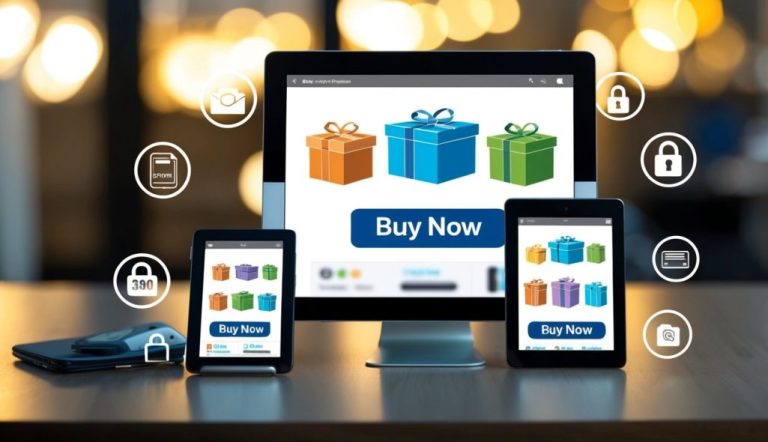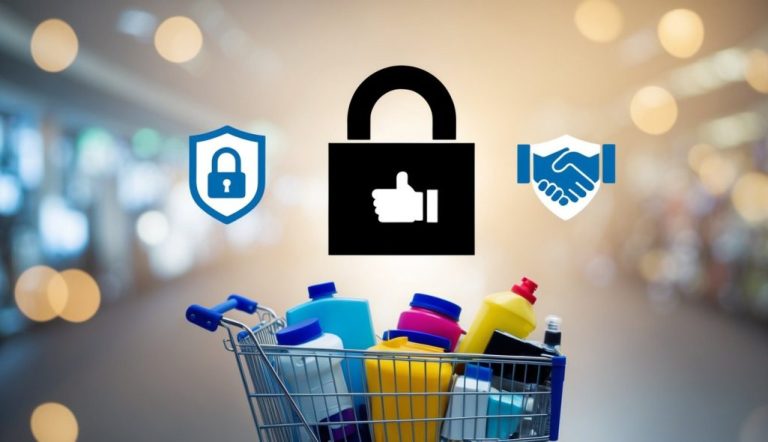Loyalty programs are a game-changer for online stores looking to build long-term relationships with their customers. These programs not only encourage repeat business but also increase customer satisfaction by offering rewards for purchases. They help you tap into your customer’s loyalty by providing incentives that keep them coming back for more.

Creating a successful loyalty program involves choosing the right type, such as points-based or tiered systems, and making sure it’s easy for customers to understand and use.
With helpful tools like Smile or Yotpo, setting up a loyalty program on platforms like Shopify can be a breeze. These tools assist you in offering personalized rewards and referral bonuses that can boost your store’s popularity.
Loyalty programs are not just about rewards; they can also provide valuable insights into customer behavior. This information can help you tailor your marketing strategies and better understand your audience. The key is to design a program that aligns with your brand and meets your customers’ expectations.
Understanding Loyalty Programs
Loyalty programs are strategic tools that encourage repeat purchases and build a strong customer base. They come in various formats like points systems and tier-based programs, each offering unique benefits to both businesses and customers.
Types of Loyalty Programs
There are several types of loyalty programs businesses can implement. The points system lets customers earn points for every purchase, which they can later redeem for rewards. This approach is simple and direct.
Tier-based programs provide different levels of benefits depending on customer spending, like the example of Sephora’s tiered system. This encourages more spending to reach higher tiers.
Subscription programs charge a fee for membership, offering immediate benefits such as discounts or exclusive access. Known as paid loyalty programs, these work well for committed customers.
The value-based loyalty program focuses on aligning with customer values, such as supporting charities. This builds emotional connections, fostering loyalty beyond typical incentives.
Benefits of Implementing a Loyalty Program
Implementing a loyalty program can significantly benefit your business. Loyalty programs enhance customer retention by fostering a sense of belonging and appreciation. They encourage increased spending, as customers often purchase more to earn rewards or reach a new tier.
Such programs are excellent for gathering valuable customer data. A coalition loyalty program is an example that builds a comprehensive database across multiple vendors to increase engagement.
Loyalty programs also provide a competitive edge by differentiating your business in the market. They support long-term relationships with customers and drive repeat business through personalized experiences.
Designing a Loyalty Program
Creating a loyalty program involves careful planning to enhance customer engagement and foster repeat business. By focusing on structuring rewards, personalizing experiences, and using gamification, you can design an effective program that resonates with your audience.
Structuring Rewards and Tiers
When designing your loyalty program, consider using a tiered structure. This encourages customers to spend more to reach higher levels, which offer increased rewards. Common tiers include basic, silver, gold, and platinum. Each level can provide different rewards such as discounts, exclusive products, or early access to sales.
Consider adding a points system, where customers earn points for each purchase. These points can be redeemed for rewards, free products, or future discounts. Clearly outline the benefits at each tier to motivate continued engagement.
Personalizing the Customer Experience
Personalization is key to connecting with your customers. Use data to tailor the experience based on purchase history or preferences. This could mean suggesting products they’re likely to buy or sending personalized offers on their birthday.
Consider segmenting customers into groups based on behavior. This allows you to create targeted campaigns that feel more relevant. Personalized communication can enhance loyalty and make customers feel valued, leading to higher satisfaction and retention.
Gamification Strategies
Integrating gamification can make your loyalty program more engaging. Incorporate elements such as challenges, badges, or leaderboards. For example, set up monthly challenges for customers to earn extra points by completing specific tasks or making purchases within a timeframe.
Use badges or achievements to reward customers for their engagement milestones. This can foster a sense of accomplishment and motivate further participation. Introducing friendly competition through leaderboards can encourage interaction and increase customer excitement about earning rewards.
Loyalty Programs and Customer Behavior
Loyalty programs influence customer behavior by encouraging repeat purchases and enhancing customer retention. By analyzing data, businesses can better understand buying patterns and tailor their strategies to maximize customer lifetime value.
Incentivizing Repeat Purchases
Loyalty programs play a crucial role in encouraging repeat business. By offering rewards, such as discounts or points for each purchase, customers are motivated to return to your store. For example, giving points for every dollar spent can encourage customers to make more frequent purchases.
Another strategy is offering exclusive deals to loyalty program members. When customers feel they are getting special treatment or access to unique products, they are more likely to come back. These incentives effectively build a habit of regular shopping among your customer base.
Implementing tiered reward levels can also drive engagement. As customers progress through different levels, they unlock more benefits. This structure not only fosters loyalty but also increases their spending over time.
Enhancing Customer Retention
Customer retention is about keeping existing customers coming back, which is often more cost-effective than acquiring new ones. Loyalty programs help by creating a more personalized shopping experience. When customers receive tailored offers based on their past purchases, they feel valued.
Engagement through loyalty programs can lead to higher customer lifetime value. The longer a customer stays with you, the more they are likely to spend overall. Providing consistent and valuable rewards can transform occasional shoppers into loyal clients.
Another way loyalty programs enhance retention is through building a sense of community. Features such as community forums or exclusive events for loyalty members can make customers feel like part of a group, strengthening their connection to your brand.
Data Analysis and Buying Patterns
Analyzing customer data collected through loyalty programs helps you understand buying behavior more deeply. By examining purchase history, you can identify trends in what your customers prefer, allowing you to adjust your inventory and marketing strategies accordingly.
Data analysis can also reveal which rewards are most effective in driving sales. Understanding which incentives lead to repeat purchases helps in optimizing the loyalty program for maximum impact.
Lastly, data helps identify segments within your customer base. By knowing who your most valuable customers are, you can focus efforts on enhancing their experience, boosting both satisfaction and loyalty. This approach ensures that your marketing efforts are targeted, efficient, and effective.
Maximizing the Impact of Rewards Programs
To fully leverage the potential of rewards programs, you need a strong marketing approach, seamless integration with existing strategies, and a focus on encouraging customers to share their experiences. These tactics help build trust and customer satisfaction.
Marketing Your Loyalty Program
Effectively marketing your loyalty program ensures it reaches the right audience. Start by using your existing communication channels like email newsletters, social media, and your website. Make the program visually appealing and easy to understand, highlighting exclusive deals and rewards that motivate customer participation.
Consider segmenting your audience to personalize marketing messages. For instance, tailor offers based on previous purchases, which can increase interest and engagement. A simple and dedicated sign-up process on your website can also enhance participation. Keep potential users informed about how they can benefit and build trust in your program.
Integrating with Marketing Strategies
Your rewards program should not exist in isolation. It must be integrated seamlessly with your other marketing strategies. Align your loyalty program with seasonal promotions or new product launches to drive customer interest. This integration can help create a consistent brand message and enhance overall marketing effectiveness.
Collaborate with influencers who share your brand’s values to boost visibility. They can introduce your rewards program to a wider audience, driving enrollment and enhancing customer satisfaction. Regularly assess the performance of your loyalty program through analytics to refine your strategy and achieve optimal results.
Driving Word-of-Mouth Marketing
Word-of-mouth marketing remains one of the most effective ways to promote your loyalty program. Encourage satisfied customers to share their positive experiences with friends and family. Provide incentives for referrals, such as bonus points or discounts, which can naturally enhance the spread of your program.
Create a community around your brand by engaging with customers on social media and encouraging them to share stories about how they benefited from the program. This not only boosts trust but also attracts new members who want to enjoy similar rewards. Be responsive and attentive to customer feedback to keep the program attractive and relevant.
Operational Aspects of Loyalty Programs
Effective loyalty programs require a structured approach. Key components include technology platforms, adherence to privacy laws, and strong management practices. Balancing these aspects can enhance the customer experience and build trust in the ecommerce space.
Technology and Platform Considerations
Choosing the right technology platform is crucial for the success of loyalty programs. You should look for platforms that integrate seamlessly with your existing ecommerce systems. A good platform will manage data efficiently, track customer interactions, and provide insights into shopping habits.
Consider using cloud-based solutions for scalability and flexibility. Ensure that the platform supports various devices to enhance the customer experience during online shopping. By implementing secure and reliable technology, you can further build trust with your customers, ensuring they feel confident when using the program.
Compliance and Privacy Policies
Compliance with privacy laws is essential when managing customer data. You must be transparent about what data is collected and for what purpose. Regulations such as GDPR in Europe require that customers give explicit consent for data collection.
Ensure your privacy policy is up-to-date and easy to understand. By prioritizing privacy and compliance, you not only protect your business from potential legal issues but also build trust with your customers. Trustworthy programs reassure customers that their personal information is safe in their online shopping experience.
Customer Support and Program Management
Strong customer support is vital to the effectiveness of your loyalty program. You need a responsive support team to address any questions or issues that arise. Develop a system where customers can easily reach out for help and receive timely responses.
Effective management involves regularly reviewing program performance and making necessary adjustments. By focusing on customer feedback, you can enhance the program to meet changing needs. Consistent program management and attentive customer support improve the overall customer experience, encouraging ongoing participation in the loyalty program.
Measuring Program Effectiveness
To determine how well your online store’s loyalty program is working, it’s important to focus on key metrics and gather customer feedback. By doing this, you can make necessary adjustments to boost sales and enhance brand loyalty.
Metrics to Watch
Tracking the right metrics is crucial for evaluating your loyalty program. Start with Repeat Purchase Rate, which shows how often customers return to buy again. This indicates their level of satisfaction and engagement. Monitoring the Return on Investment (ROI) helps you see if the benefits outweigh the costs by comparing the earnings from the program to its expenses.
Average Order Value (AOV) is another useful metric. It measures the average amount spent each time a customer orders and reflects how effectively the program encourages additional spending. You should also monitor changes in the Customer Lifetime Value (CLV). This metric shows the long-term value of a customer, highlighting their overall contribution to your store.
Customer Feedback and Adjustments
Gathering customer feedback is essential for refining your loyalty program. Surveys, reviews, and direct feedback help identify areas that need improvement. Listening to customers can reveal common issues and preferences, allowing you to make data-driven changes.
For instance, if feedback suggests that rewards are not enticing enough, you might adjust the incentives. By acting on feedback, you can enhance the customer experience and boost sales.
Implementing a process for regular feedback collection ensures you stay informed about customer needs. This ongoing dialogue helps strengthen brand loyalty and keeps your program relevant and effective.
Case Studies
In the world of eCommerce, loyalty programs are key tools for engaging and retaining customers. This section explores specific examples of successful loyalty programs used by online stores.
Successful Online Loyalty Programs
Many companies have implemented innovative loyalty programs to enhance customer engagement. Starbucks Rewards reported a significant increase in sales by offering exclusive perks like free drinks. This program enables users to earn stars with each purchase. They can then redeem these stars for rewards.
Nordstrom’s loyalty program called The Nordy Club allows members to earn points for every dollar spent. It offers various perks, including early access to sales and special events.
Macy’s Loyallist is another noteworthy program where members receive one point for every dollar spent. Once they accumulate 1,000 points, they earn a $10 reward, enticing customers to make return purchases.
Sears’ Shop Your Way program also stands out by providing personalized deals based on customer preferences. This system lets members earn points while shopping not just in-store but also online, redeemable for future discounts.
These programs emphasize tailored rewards and consistent engagement to keep members active and loyal to the brand.
Frequently Asked Questions
Loyalty programs can boost customer retention for online stores. Learn about the key features of these programs, how to set one up for your business, and the benefits they provide. Discover popular software integrations and get inspired with creative ideas for digital retailers.
What are the characteristics of successful online loyalty programs?
Successful online loyalty programs often have user-friendly designs, clear rewards, and personalized offers. They use data insights to tailor experiences and consistently engage customers. Programs such as points-based systems or tiered rewards can motivate repeat purchases by offering tangible benefits.
How can I implement a loyalty program for my e-commerce business?
To start a loyalty program, first define your goals and budget. Then, choose a suitable model that aligns with your business and customer needs. Platforms like Shopify offer guides and tools to help set up programs. These make it easier to track customer interactions and reward engagement.
What are the benefits of establishing a loyalty program for an online store?
Loyalty programs help increase customer retention and repeat purchases. They also encourage brand loyalty by rewarding customers for their ongoing engagement. By making customers feel valued, you can foster a stronger connection with your brand. This can lead to increased sales and positive word-of-mouth.
Which loyalty program software integrates well with platforms like Shopify?
Platforms like Shopify can integrate with various loyalty program software, offering features for tracking rewards and customer activity. Popular options include Growave and Smile.io, which can streamline the setup process while providing robust tools to manage and enhance your program’s efficacy.
What innovative ideas can be applied to loyalty programs for digital retailers?
For a fresh approach, consider incorporating gamified elements, such as challenges or badges. Create a community aspect by rewarding customers for sharing your brand on social media. Offering exclusive early access to new products or special events can also make your program stand out and keep it engaging.
Are there any effective and free loyalty program solutions for online businesses?
Free loyalty program solutions like stamps or basic point systems are available. These entry-level options often provide essential features to start rewarding your customers without upfront costs. Some software also offers free plans with limited features, providing a good starting point for small businesses.





